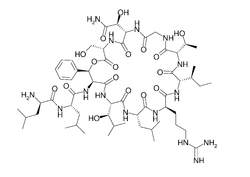Katanosin
 | |
| Names | |
|---|---|
| IUPAC name
N-[6-(2-amino-1-hydroxy-2-oxoethyl)-15-butan-2-yl-18-[3-(diaminomethylideneamino)propyl]-12-(1-hydroxyethyl)-3-(hydroxymethyl)-24-(1-hydroxy-2-methylpropyl)-21-(2-methylpropyl)-2,5,8,11,14,17,20,23,26-nonaoxo-28-phenyl-1-oxa-4,7,10,13,16,19,22,25-octazacyclooctacos-27-yl]-2-[(2-amino-4-methylpentanoyl)amino]-4-methylpentanamide | |
| Other names
Lysobactin | |
| Identifiers | |
| 116340-02-4 | |
| 3D model (Jmol) | Interactive image |
| ChemSpider | 170823 |
| MeSH | B Katanosin B |
| PubChem | 197270 |
| |
| |
| Properties | |
| C58H97N15O17 | |
| Molar mass | 1,276.50 g·mol−1 |
| Appearance | Solid |
| Density | 1.42 g/cm3 |
| Hazards | |
| Main hazards | Xn |
| Except where otherwise noted, data are given for materials in their standard state (at 25 °C [77 °F], 100 kPa). | |
| | |
| Infobox references | |
Katanosins are a group of antibiotics (also known as lysobactins). They are natural products with strong antibacterial potency.[1] So far, katanosin A and katanosin B (lysobactin) have been described.
Sources
Katanosins have been isolated from the fermentation broth of microorganisms, such as Cytophaga.[2] or the Gram-negative bacterium Lysobacter sp.[3]
Structure
Katanosins are cyclic depsipeptides (acylcyclodepsipeptides). These proteinogenic structures are not regular proteins from primary metabolism. They origin from the bacterial secondary metabolism. Accordingly, various non-proteinogenic (non-ribosomal) amino acids are found in katanosins, such as 3-hydroxyleucine, 3-hydroxyasparagine, allo-threonine and 3-hydroxyphenylalanine. All katanosins have a cyclic and a linear segment (“lariat structure”). The peptidic ring is closed with an ester bond (lactone).
Katanosin A and B differ in the amino acid position 7. The minor metabolite katanosin A has a valine in this position, whereas the main metabolite katanosin B carries an isoleucine.
Biological activity
Katanosin antibiotics target the bacterial cell wall biosynthesis. They are highly potent against problematic Gram-positive hospital pathogens such as staphylococci and enterococci. Their promising biological activity attracted various biological and chemical research groups. Their in-vitro potency is comparable with the current “last defence” antibiotic vancomycin.
Chemical synthesis
The first total syntheses of katanosin B (lysobactin) have been described in 2007.[4][5]
References
- ↑ Bonner, DP; O'Sullivan, J; Tanaka, SK; Clark, JM; Whitney, RR (1988). "Lysobactin, a novel antibacterial agent produced by Lysobacter sp. II. Biological properties". The Journal of antibiotics. 41 (12): 1745–51. doi:10.7164/antibiotics.41.1745. PMID 3209466.
- ↑ O'Sullivan, J; McCullough, JE; Tymiak, AA; Kirsch, DR; Trejo, WH; Principe, PA (1988). "Lysobactin, a novel antibacterial agent produced by Lysobacter sp. I. Taxonomy, isolation and partial characterization". The Journal of antibiotics. 41 (12): 1740–4. doi:10.7164/antibiotics.41.1740. PMID 3209465.
- ↑ Shoji, J; Hinoo, H; Matsumoto, K; Hattori, T; Yoshida, T; Matsuura, S; Kondo, E (1988). "Isolation and characterization of katanosins a and B". The Journal of antibiotics. 41 (6): 713–8. doi:10.7164/antibiotics.41.713. PMID 3403364.
- ↑ Von Nussbaum, F; Anlauf, S; Benet-Buchholz, J; Häbich, D; Köbberling, J; Musza, L; Telser, J; Rübsamen-Waigmann, H; Brunner, NA (2007). "Structure and total synthesis of lysobactin (katanosin B)". Angewandte Chemie International Edition in English. 46 (12): 2039–42. doi:10.1002/anie.200604232. PMID 17211904.
- ↑ Guzman-Martinez, A; Lamer, R; Vannieuwenhze, MS (2007). "Total synthesis of lysobactin". Journal of the American Chemical Society. 129 (18): 6017–21. doi:10.1021/ja067648h. PMC 2151959
 . PMID 17432854.
. PMID 17432854.